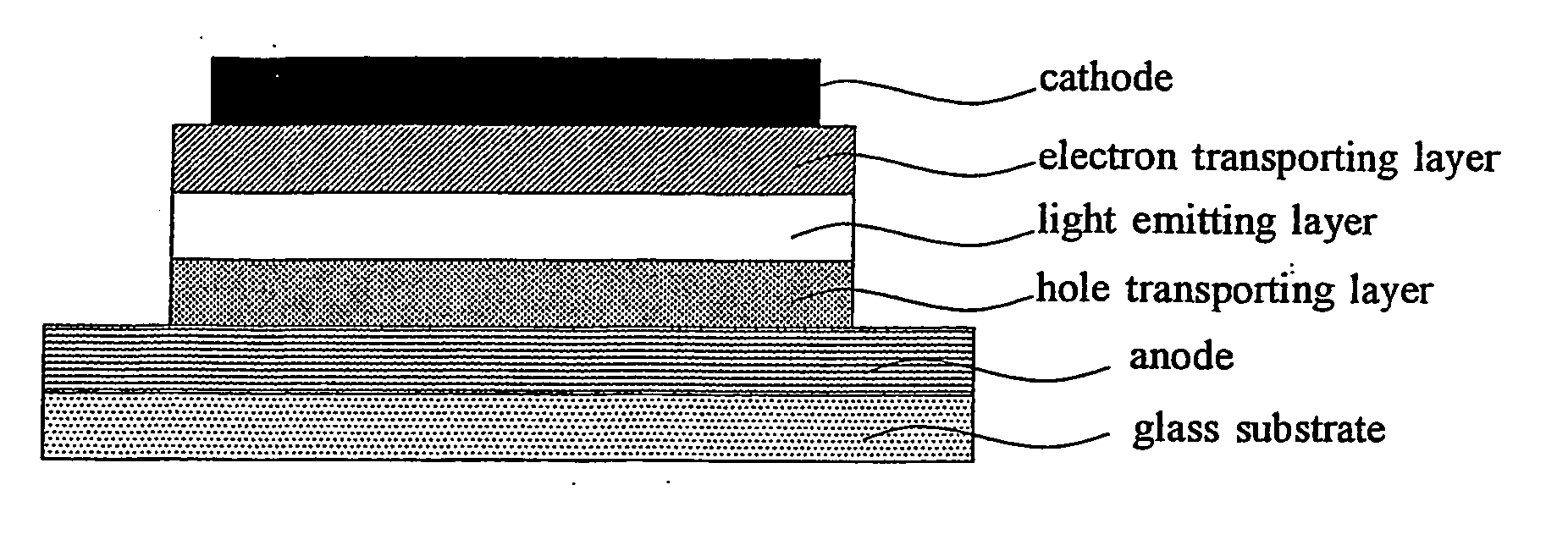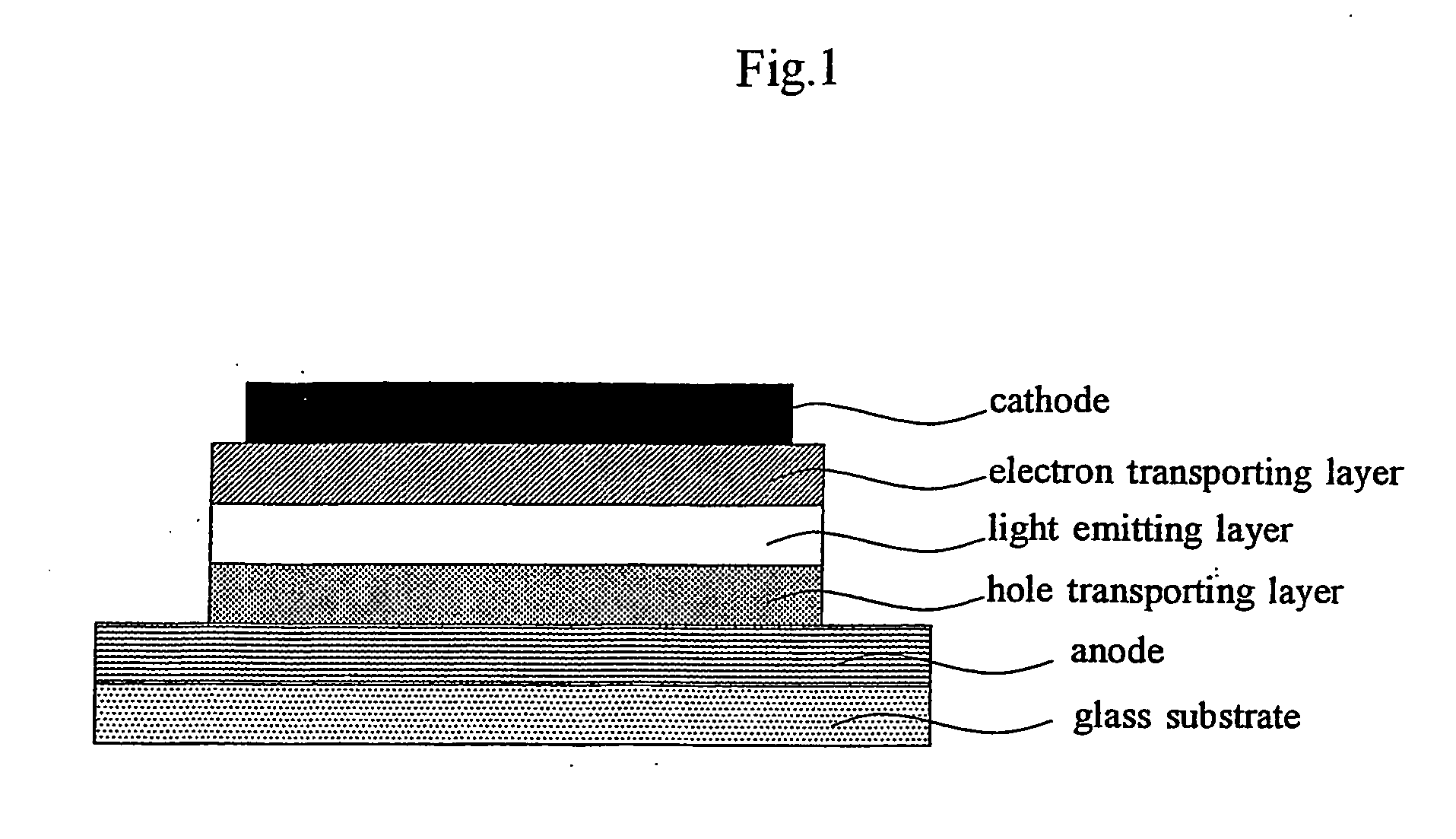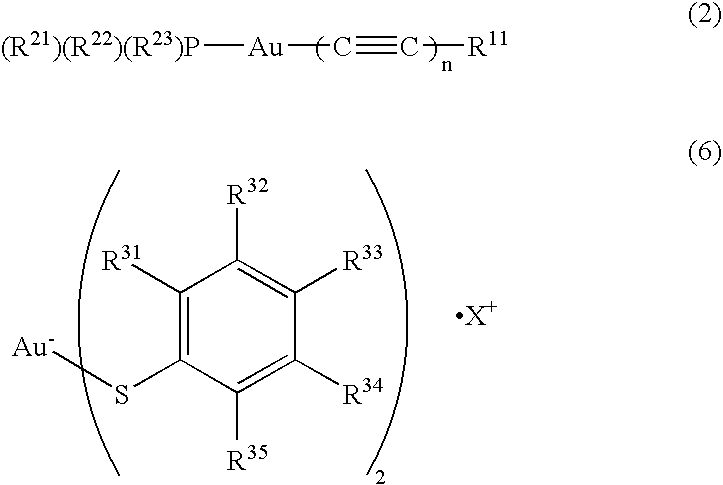Organic light emitting device material and organic light emitting devcie
a technology of light-emitting devices and organic materials, which is applied in the direction of gold organic compounds, other domestic articles, organic compounds of the group 5/15 elements, etc., can solve the problems of separation or segregation, and the difficulty of forming an organic thin film with a uniform thickness
- Summary
- Abstract
- Description
- Claims
- Application Information
AI Technical Summary
Benefits of technology
Problems solved by technology
Method used
Image
Examples
example 1
Synthesis of Phenylbutadiynyl(triphenylphosphine) Gold (I) (Compound 1-1)
[0075]
[0076] To a 10 ml ethanol solution of 0.50 g (4.1 mmol) of thiodiglycol was added 10 ml of an aqueous solution of 0.85 g (2.1 mmol) of chloroaurate (III) tetrahydrate, and the resultant mixture was stirred at room temperature for half an hour. After the reaction solution was cooled to 0° C., 0.54 g (2.1 mmol) of triphenylphosphine in 10 ml of an acetone-ethanol (volume ratio 1:1) solution was added thereto, and stirred for half an hour. The reaction solution was poured into 100 ml of water, and generated precipitate was filtered, and then dried under reduced pressure. Subsequently, 98 mg of the obtained white solids was suspended in 5 ml of methanol, to which were added 30 mg of phenylbutadiyne (0.24 mmol) and 15 mg of sodium methoxide (0.28 mmol), and the resultant mixture was stirred at room temperature for 16 hours. After the solvent was distilled off under reduced pressure from the obtained reaction ...
examples 2 to 11
[0077] Compounds 1-2 to 1-11 were synthesized in the same manner as compound 1-1 was synthesized in Example 1, by using organic phosphorous compound P(R101) (R102) (R103) in place of triphenylphosphine and by using alkyne H(C2)nR104 in place of phenylbutadiyne.
TABLE 1Elemental analysis(%)ExampleCompoundR101R102R103R104nCobs(Ccalcd)Hobs(Hcalcd)11-1PhPhPhPh257.55(57.29)3.45(3.52)21-2PhPhPh158.81(59.03)3.19(3.63)31-3PhPhPh160.57(60.39)3.90(3.80)41-4PhMeMeo-tol248.34(48.12)3.55(3.83)51-5PhPhEt243.83(43.79)2.95(2.86)61-6PhPhEt247.01(46.64)3.29(3.50)71-7PhPhEt141.44(41.30)3.14(3.23)81-8PhPhEtCOOMe143.69(43.83)3.81(3.47)91-9PhPhEtMe342.58(42.77)3.52(3.11)101-10EtOEtOEtOt-Bu236.15(35.91)5.02(5.17)111-11PhOPhOPhO252.70(52.67)3.99(4.10)
example 12
Synthesis of Hexanetriynediylbis(triphenylphosphine) digold (I) (Compound 2-1)
[0078]
[0079] To a 10 ml ethanol solution of 0.50 g (4.1 mmol) of thiodiglycol was added 10 ml of an aqueous solution of 0.85 g (2.1 mmol) of chloroaurate (III) tetrahydrate, and the resultant mixture was stirred at room temperature for half an hour. After the reaction solution was cooled to 0° C., 0.54 g (2.1 mmol) of triphenylphosphine in 10 ml of an acetone-ethanol (volume ratio 1:1) solution was added thereto, and stirred for half an hour. The reaction solution was poured into 100 ml of water, and generated precipitate was filtered, and then dried under reduced pressure. Subsequently, 78 mg of the obtained white solids was suspended in 10 ml of methanol, to which were added 8.5 mg of sodium methoxide (0.16 mmol) and 19 mg of bis(trimethylsilyl)hexatriyne (0.087 mmol), and the resultant mixture was stirred at room temperature for 3 hours. Generated tawny precipitate was filtered through a glass filter, ...
PUM
| Property | Measurement | Unit |
|---|---|---|
| Mass | aaaaa | aaaaa |
| Mass | aaaaa | aaaaa |
| Mass | aaaaa | aaaaa |
Abstract
Description
Claims
Application Information
 Login to View More
Login to View More - R&D
- Intellectual Property
- Life Sciences
- Materials
- Tech Scout
- Unparalleled Data Quality
- Higher Quality Content
- 60% Fewer Hallucinations
Browse by: Latest US Patents, China's latest patents, Technical Efficacy Thesaurus, Application Domain, Technology Topic, Popular Technical Reports.
© 2025 PatSnap. All rights reserved.Legal|Privacy policy|Modern Slavery Act Transparency Statement|Sitemap|About US| Contact US: help@patsnap.com



